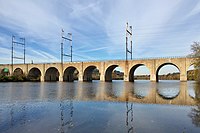Raritan Bay
This article needs additional citations for verification. (January 2021) |
| Raritan Bay | |
|---|---|
Sandy Hook |
Raritan Bay is a
History
Archeological evidence suggests that humans were already in the region at the close of the
Geology

The
As the Wisconsin glaciers melted, the
Economy and ecology
The bay supported a lucrative fishing and
Fishing and farming slowly gave way to industries including ship building, ceramics, chemicals and paint manufacturing, electrolytic copper refining, and petroleum refining. In the
For most of the 20th century, the shores of Arthur Kill have been home to the largest petroleum importing, refining, and storage facilities on Earth; as a consequence the estuary has been host to major and minor oil spills. In addition, Arthur Kill drains the area encompassing the second largest landfill on Earth (Fresh Kills Landfill). This landfill, and others along the Raritan River, provide an ample supply of leachate to the waterways. Chemical wastes cause stress and disruption of the life cycles of plankton, shellfish and other invertebrates, and the fish, birds, and other wildlife that they support.[citation needed]
The result was an ecological disaster. The bay approached sterile conditions at the peak of pollution and algal bloom-induced anoxia. Environmental actions from the 1970s to present have helped slowly bring back sea life, but current conditions pale to the wealth of marine resources of the past; certain species of fish and birds continue to decline, and the introduction of tenacious exotic species from around the world contribute to their decline. As a sign of optimism though, oysters are beginning to naturally reappear in the Hudson River after having vanished completely about the time of World War II.[3]
Regional industrial overdevelopment and other pollution factors have raised PCB levels in the fish catch and prompted government recommendations against its routine consumption.[1][4]
The bay is crossed by a
Aquatic species
Raritan Bay's fish include
See also
- Long Island Sound
- Jamaica Bay
- Lower New York Bay
- Upper New York Bay
- New York Harbor
- Geography of New York-New Jersey Harbor Estuary
- Marine life of New York-New Jersey Harbor Estuary
References
- ^ a b c d e f "Raritan Bay - Sandy Hook Bay Complex". nctc.fws.gov. Retrieved October 22, 2016.
- ^ a b Frank, Dave. "Geology of National Parks - Geologic History of Raritan Bay". 3dparks.wr.usgs.gov. National Park Service. Retrieved October 22, 2016.
- ^ U.S. Geological Survey, accessed June 24, 2008
- ^ Reynolds, Joe (April 27, 2006). "Don't Eat the Fish: PCBs in the Raritan Bay". Atlantic Herald. Archived from the original on May 9, 2006. Retrieved October 22, 2016.


